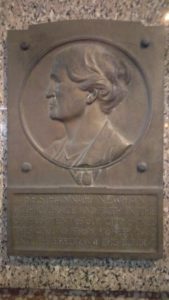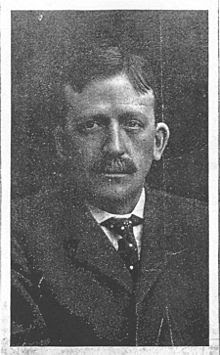
While most of us have heard the story of Mollie Walsh and her great admirer Pack jack Newman, I only just read the curious story of the second monument in Seattle. Mollie met Packer Jack in Skagway where he was smitten with her. He once shot a fellow in the legs right on Broadway so that he could not go up and visit Mollie at Log Cabin where she sold pies. Mollie later married Mike Bartlett who murdered her in Seattle in 1902. In 1930 – 28 years after Mollie’s death Newman decided to honor the memory of his “Angel of the White Pass.” He commissioned a bronze sculpture of Mollie to be placed in Skagway.
And here the statue stands today, by a children’s playground that has become known as Mollie Walsh Park.
The inscription, written by the man who lost Mollie to the man who killed her, reads:
ALONE WITHOUT HELP / THIS COURAGEOUS GIRL / RAN A GRUB TENT / DURING THE GOLD RUSH / OF 1897-1898. / SHE FED AND LODGED / THE WILDEST / GOLD CRAZED MEN. / GENERATIONS / SHALL SURELY KNOW / THIS INSPIRING SPIRIT. / MURDERED OCT. 27, / 1902.
Jack Newman was unable to attend the dedication ceremony in Skagway, but sent a message.
“I’m an old man and no longer suited to the scene, for Mollie is still young and will remain forever young, her spirit lingers still reach across the years and play on the slackened strings of my old heart and my heart still sings – MOLLIE! – my heart still sings, but in such sad undertone that none but God and I can hear . . .”
However, his wife, Hannah let her husband know that she was less than thrilled with his tribute to his lost love.
To appease his wife, he quickly placed a dinner-plate-size bronze profile of Hannah on the exterior of the Washington Athletic Club, at Sixth Avenue and Union Street. The inscription:
MRS. HANNAH NEWMAN / WITH COURAGE AND FAITH IN THE / DEVELOPMENT OF OUR CITY OWNED / THIS GROUND FROM PIONEER DAYS / UNTIL THE ERECTION OF THIS BUILDING / 1930
Jack Newman died soon after Mollie’s statue was unveiled in Skagway – on May 4, 1931 of appendicitis. Although Newman had requested that he be buried in Skagway, beside Mollie’s monument, Mrs. Newman had him buried in Seattle. I could not find a photo of Hannah’s bronze on the WAC building on the corner of 6th and Union. If someone would like to photograph it, I will post it, but in the mean time here is a great picture of young Packer Jack. Cute guy!
HIs gravesite can be viewed by going to Findagrave and entering the Memorial ID number 104500403
I was contacted recently by Art Petersen who has spent years researching Mollie Walsh and Packer Jack Newman. In fact he has written a new book entitledMarch 2022 update
Promised Lands, MOLLIE WALSH: An Irish-American Story (2021 Klondike Research). available from Klondikeresearch.com
In this book he describes new corrections which I will now point out:
A few facts:
Packer Jack never shot anyone.
The statue was erected after Packer Jack died.
Packer Jack wanted to be buried at Inspiration Point on the White Pass Trail.
Leo Alphonse was born on August 27, 1900, not 27 May 1899. He forged his birthdate to be old enough to join the U.S. Army.
Mike Bartlett did not put on a party to celebrate the birth of his son; he was not even on the boat.
Mollie did not help Reverend Dickey establish the Union Church in Skagway.
Mollie’s husband never entered an insane asylum; rather, he suffered torturously for six years after his trial before ending his own life before a horrified audience.
Here is the pic of the bronze, care of Lindsey Haight







